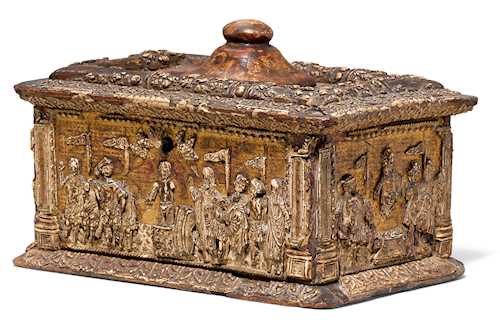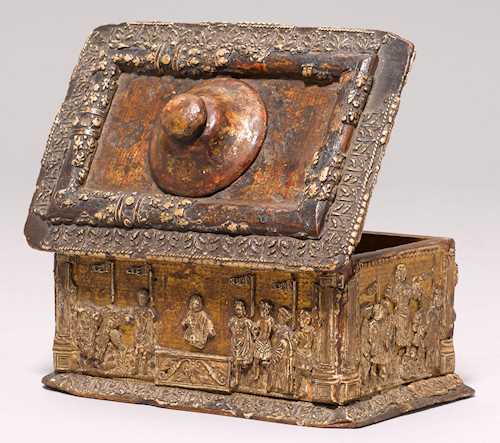
拍品 1025* - A192 家具、瓷器&银器 - Donnerstag, 18. Juni 2020, 02.00 PM
SMALL PASTIGLIA CASKET,
Renaissance, Italy, probably Ferrara, beginning of the 16th century.
Wooden core with pastiglia in relief and gilt. Circumferential depictions of Roman soldiers, probably the story of John the Baptist. Leaves and decorative friezes. Rectangular body with hinged cover and finial (probably later).
16 x 11 x 10 cm.
Feet, missing. Pastiglia decoration with numerous losses and in part incomplete.
Pastiglia is the name for a partially pasty, applied mass, usually consisting of chalk mixed with pigments and binders. This technique is mainly used for relief-like highlighting of certain depictions on panel paintings and was already known in Ancient Egypt, where mummy portraits were decorated with pastiglia. Later, this type of relief was also used in the Byzantine area, and from the 12th century onwards in southern Europe, from where the technique of pastiglia spread northwards.
Comparable pieces can be found in the Metropolitan Museum in New York (Inventory No. 117.190.585) and in the Musée nationale de la Renaissance in the Chateau d'Écouen near Paris (Inventory No. ECL1750).
Pastiglia is the name for a partially pasty, applied mass, usually consisting of chalk mixed with pigments and binders. This technique is mainly used for relief-like highlighting of certain depictions on panel paintings and was already known in Ancient Egypt, where mummy portraits were decorated with pastiglia. Later, this type of relief was also used in the Byzantine area, and from the 12th century onwards in southern Europe, from where the technique of pastiglia spread northwards.
Comparable pieces can be found in the Metropolitan Museum in New York (Inventory No. 117.190.585) and in the Musée nationale de la Renaissance in the Chateau d'Écouen near Paris (Inventory No. ECL1750).
CHF 6 000 / 8 000 | (€ 6 190 / 8 250)
以瑞士法郎銷售 CHF 6 875 (包含買家佣金)
所有信息随时可能更改。


